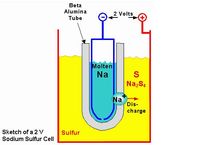
Lots of solutions have been proposed. Underground storage in the form of compressed gas. Flywheels. Batteries of all kinds have been talked about, but most don't scale.
There is an exception.
NaS batteries use liquid sulfer as their positive electrode and liquid sodium as their negative electrode, separated by a solid ceramic called beta-alumina. Electrons move through the beta alumina from sulfer to sodium or (if it's charging up) from sodium to sulfer.
The system is said to be 89% efficient, meaning only 11% of the energy is lost in the form of heat. Because both parts of the battery are already liquid, it can store an enormous amount of energy in a relatively small space.

Unfortunately you can't buy one.
All of NGK's production capacity for at least the next several years, has been bought by Amplex, a Danish company which is in turn owned by RUBENIUS of the United Arab Emirates.
At the Cancun conference on global warming RUBENIUS announced its biggest deal to date, which will supply 1 GW of storage to Mexico, which will place the batteries near the U.S. border.
The deal was announced by Mexican President Felipe Calderon (left) who said it will assure interconnection between the U.S. and Mexican electric grids. The market will be pushed by AB 2514, an alternative energy bill California signed into law a few months ago.
Isn't that just nice, a huge facility filled with molten sulfer and sodium just across from San Diego, on which all our efforts to store-and-forward wind or solar energy are supposed to depend?
I feel safer already, don't you?











LOL..I can sympathize with you with that one, it’s a bit unnerving to find out that those kind of solar powered facilities near by.
This is a good start but it should always be safety first.
LOL..I can sympathize with you with that one, it’s a bit unnerving to find out that those kind of solar powered facilities near by.
This is a good start but it should always be safety first.
Just what you want in your back yard. Almost as welcome as a nuclear power plant.
Just what you want in your back yard. Almost as welcome as a nuclear power plant.
Great going – proposing sulfur bombs as a replacement for good old gas and oil.
Great going – proposing sulfur bombs as a replacement for good old gas and oil.
Just goes to show. There are no easy solutions or silver bullets out there. Every power source comes with an upside and a downside.
Just goes to show. There are no easy solutions or silver bullets out there. Every power source comes with an upside and a downside.
There is nothing especially dangerous about salt batteries. They’re not explosive.
There are also many alternative technologies for storing large amounts of grid energy beyond these batteries.
In Alabama there’s a compressed-air system being built by an American company that created a stable salt dome underground, then uses excess grid electricity to compress air into the space, releasing it when needed to create new electricity directly.
That’s just one example. There are also flywheel systems, fuel cells, and simple electrolysis — which reverses the process by using electricity to separate hydrogen from oxygen in water.
A more flexible grid, which can buy as well as sell from anyone, and which has near-term storage near consumers, is also less vulnerable to terrorism than the present system — much less vulnerable.
Idiots like Peng have become so unhinged they argue against national security in the name of national security. Their hatred toward their fellow Americans, from the President down to this humble blogger, is sad, twisted, un-Christian and (most important) self-defeating.
There is nothing especially dangerous about salt batteries. They’re not explosive.
There are also many alternative technologies for storing large amounts of grid energy beyond these batteries.
In Alabama there’s a compressed-air system being built by an American company that created a stable salt dome underground, then uses excess grid electricity to compress air into the space, releasing it when needed to create new electricity directly.
That’s just one example. There are also flywheel systems, fuel cells, and simple electrolysis — which reverses the process by using electricity to separate hydrogen from oxygen in water.
A more flexible grid, which can buy as well as sell from anyone, and which has near-term storage near consumers, is also less vulnerable to terrorism than the present system — much less vulnerable.
Idiots like Peng have become so unhinged they argue against national security in the name of national security. Their hatred toward their fellow Americans, from the President down to this humble blogger, is sad, twisted, un-Christian and (most important) self-defeating.
Ah the true Dana comes out again, and in typical liberal style. When confronted with facts that they can’t deal with they start calling people idiots.
Great Going Dana!
And by the way, how’s your Hope’nChange Hussein working out for ya? LOL! My fellow (USA-born) Americans handed him a severe ‘You Fail’ card in November. Now, that’s a bummer for you because you’ve been saying that he’s God for nearly two years. Our Arab-hand-licker-in-Chief is just Carter 2. You just can’t deal with Real American voters!
Oh… and you mentioned something about Christians. Aren’t you going to a Baptist church and at the same time you approve of the slaughter of unborn life? Oops! Dana the murderer!
Ah the true Dana comes out again, and in typical liberal style. When confronted with facts that they can’t deal with they start calling people idiots.
Great Going Dana!
And by the way, how’s your Hope’nChange Hussein working out for ya? LOL! My fellow (USA-born) Americans handed him a severe ‘You Fail’ card in November. Now, that’s a bummer for you because you’ve been saying that he’s God for nearly two years. Our Arab-hand-licker-in-Chief is just Carter 2. You just can’t deal with Real American voters!
Oh… and you mentioned something about Christians. Aren’t you going to a Baptist church and at the same time you approve of the slaughter of unborn life? Oops! Dana the murderer!
I hope they can provide solutions for the oil crisis problem. Its sad that NKG batteries can’t be sold to the US citizens.
I hope they can provide solutions for the oil crisis problem. Its sad that NKG batteries can’t be sold to the US citizens.
Are these liquid sulfur products have patents. Can’t the US scientist make one for their own?
Are these liquid sulfur products have patents. Can’t the US scientist make one for their own?
Electrochemical energy storage companies should get more creative and stop trying to scale up small battery systems. Portable batteries have a lot of packaging to make them safe for consumers. With NaS batteries, it is inefficient to insulate individual batteries or small packs of batteries. Why not adopt a flow battery system, and store the chemicals in giant tanks?
Electrochemical energy storage companies should get more creative and stop trying to scale up small battery systems. Portable batteries have a lot of packaging to make them safe for consumers. With NaS batteries, it is inefficient to insulate individual batteries or small packs of batteries. Why not adopt a flow battery system, and store the chemicals in giant tanks?